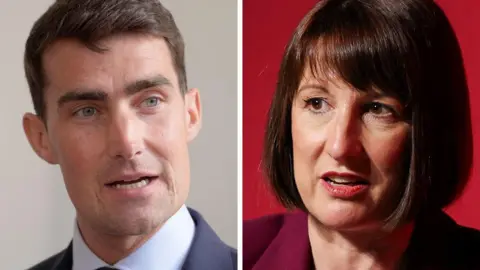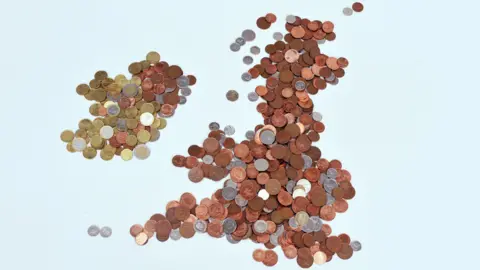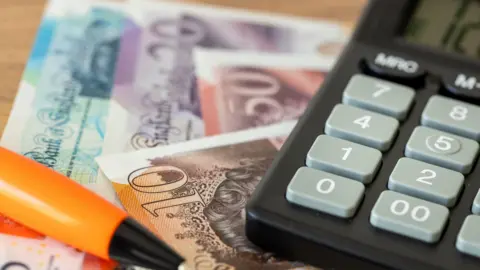Irish budget: Stark difference in UK and Ireland’s budgets
 PA and Reuters
PA and ReutersAs Ireland’s finance minister delivered his budget on Tuesday afternoon Dublin was bathed in golden autumn sunlight.
The minister, Jack Chambers, said his budget provided the “ways and means for continuing to deliver many more, bright and hopeful days for us all.”
He announced a series of one-off cost-of-living payments, including €250 (£208) for all households to help with energy costs.
He also gave the first details of how a €14bn (£11.7bn) tax windfall from Apple will be spent, which forms part of the €25bn (£20.8bn) budget surplus the government will have this year.
The contrast with the looming UK budget could hardly be more stark.
Expectation management?
 Getty Images
Getty ImagesThe prime minister set the tone in August warning that the budget will be “painful” and the government will have to make “big asks” of the public.
A taste of that pain came with the ending of the universal £300 winter fuel payment for pensioners.
Much of the discussion around the budget has centred on the “£22bn black hole” in the public finances and whether that should be filled with tax rises, spending cuts or a tweak to the “fiscal rules” which would allow more borrowing.
It may be that the UK government is engaging in expectation management and the budget will be less miserable than advertised.
On Friday the Chancellor gave a strong hint that she will change her self-imposed borrowing rules to allow significantly more investment in major projects.
But there is a fundamental difference between the two economies at the moment.
The UK, like many countries, is running a budget deficit, meaning it is spending more than it receives in taxes.
Tax incentives

Ireland is in the unusual position of running a big budget surplus which gives the government lots of spending options.
Ireland is able to do this because a long standing pillar of its economic strategy has become freakishly successful in recent years.
Since the 1950s the country has had a policy of using tax incentives to attract foreign investment.
Even during the country’s bailout and austerity years in the late 2000s the government maintained a 12.5% rate of corporation tax, among the lowest in the developed world.
In the middle of the last decade some of the world’s biggest companies began to reorganise their affairs in a way which meant they would pay a lot more tax in Ireland.
Ironically this was partially a response to the pressure on big companies to clean up their act on tax.
 Getty Images
Getty ImagesThe principle was that companies should declare profits in locations where they have substantial real operations or activities rather than just a low-tax location where they happen to have an office with few employees.
Ireland fitted the bill – it was a tax-friendly jurisdiction but companies like Apple had long had real operations in the country, employing thousands of people.
What came next was the legal relocation of intellectual property (IP) assets to Ireland – the most valuable profit-earning parts of these businesses.
Apple’s shift of IP assets in 2015 is widely believed to have been responsible for a wild swing in the country’s GDP that year.
The profits generated by these assets has seen a flood of corporation tax receipts into the Irish Revenue.
In 2017 Ireland raised just over €8bn in corporation tax.
By last year this had ballooned to almost €24bn and is expected to be just under €30bn this year.
 Getty Images
Getty ImagesThe Irish Fiscal Advisory Council, an independent budget watchdog, said that while large headline surpluses are forecast for the coming years, these are “driven entirely by extraordinary corporation tax receipts”.
It has used Department of Finance estimates of how much of this tax is a “windfall” to calculate that underlying budget deficits over the period 2024-2030 will add up to €50bn.
The government has acknowledged that this tax bonanza could one day end and has begun setting up a sovereign wealth fund which will invest some of the windfall corporation tax proceeds.
The consultation document for that wealth fund involved a glance across the Irish Sea.
It noted that when the UK struck oil in the North Sea no long-term savings vehicle was established, instead income tax and corporation tax rates were lowered over successive years during the 1980s.
“In effect, therefore, at least part the windfall receipts were used to fund reductions in direct taxation.”
It also looked at Norway, which used its oil money to establish one of the world’s largest wealth funds, and concluded that “the contrasting approaches of two mature, advanced economies that recorded major windfall gains offers important lessons.”


